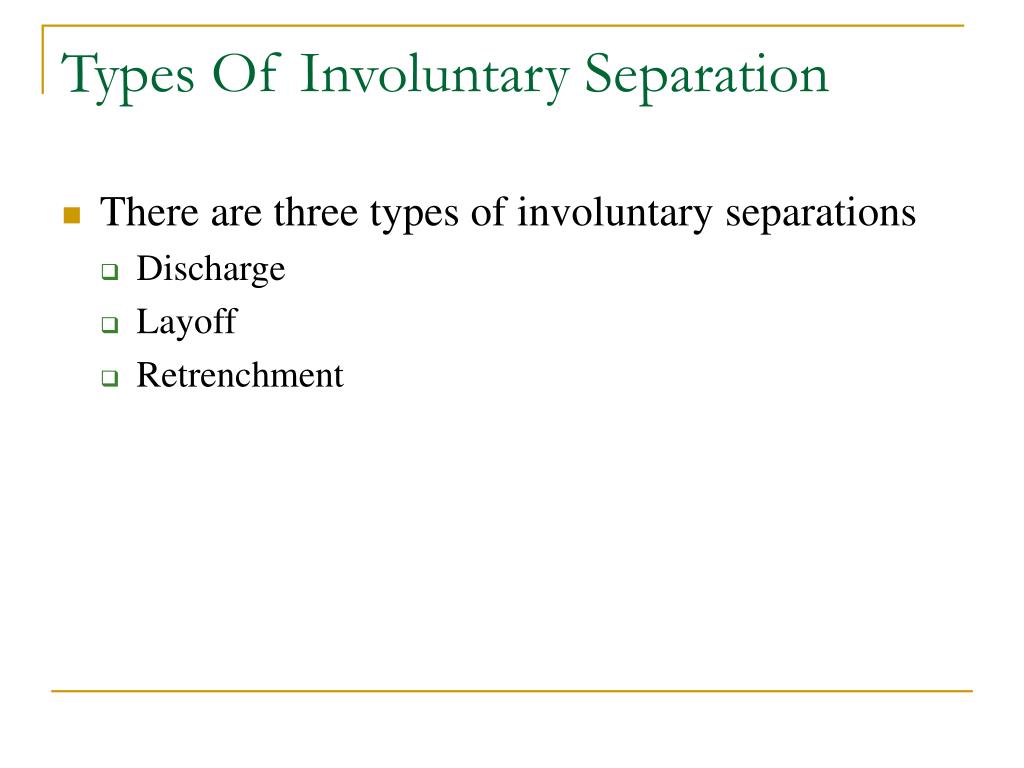Involuntary Separation Army Regulation
Involuntary Separation Army Regulation
Being separated from the United States Army involuntarily can be a challenging experience for any soldier. Understanding the Involuntary Separation Army Regulation can help provide clarity and support during this process. In this article, we will delve into the details of this regulation and provide valuable information to assist you throughout this journey. Let's explore!
1. What is Involuntary Separation Army Regulation?
The Involuntary Separation Army Regulation is a set of guidelines and policies that dictate the conditions under which a soldier may be involuntarily separated from the Army. It covers various aspects such as the reasons for separation, the procedures involved, and the rights of the soldiers. This regulation ensures fairness and transparency throughout the separation process.
Image source: SlideServe
2. Reasons for Involuntary Separation
There are several reasons why a soldier may face involuntary separation from the Army. These reasons include:
- Failure to meet performance standards
- Physical or mental health issues
- Violations of military regulations
- Substance abuse
- Criminal misconduct
It is important to note that each case is thoroughly evaluated, and the necessary steps are taken to ensure a fair and just outcome.

Image source: SlideServe
3. The Procedure for Involuntary Separation
The procedure for involuntary separation from the Army involves several steps to ensure that the rights of the soldier are protected. These steps typically include:
- Notification: The soldier receives written notification of the intent to separate, along with the reasons and relevant details.
- Counseling: The soldier has the opportunity to receive counseling and support to address the issues leading to the separation.
- Investigation: If necessary, an investigation is conducted to gather all the information related to the case.
- Decision: A decision is made based on the investigation and input from various parties involved.
- Appeals: The soldier has the right to appeal the decision through appropriate channels.
Throughout this process, it is crucial for the soldier to consult with a legal representative who specializes in military law to ensure a proper understanding and protection of their rights.
Frequently Asked Questions (FAQ)
Q1. Can I challenge the decision of involuntary separation?
A1. Yes, you have the right to challenge the decision through an appeal process. It is recommended to seek legal advice for guidance regarding the appropriate channels for filing an appeal.
Q2. Will an involuntary separation impact my future career prospects?
A2. While an involuntary separation can be a setback, it does not necessarily mean the end of your professional journey. It is essential to focus on your strengths, seek personal growth opportunities, and explore alternative career paths that value your military experience.
Q3. How can I prepare myself emotionally for an involuntary separation?
A3. Going through an involuntary separation can be emotionally challenging. It is crucial to reach out to your support network, including family, friends, and fellow soldiers who may have experienced similar situations. Additionally, seeking counseling or therapy can provide a safe space to process your emotions and develop coping strategies.
Remember, an involuntary separation from the Army does not define your worth or abilities. It may be an opportunity to embark on a new chapter in your life, filled with fresh opportunities and personal growth. Stay resilient, and know that you are not alone in this journey.
Disclaimer: The information provided in this article is for general informational purposes only. It is not intended as legal advice. Please consult with a legal professional specializing in military law for specific advice regarding your individual situation.
Involuntary Separation Army Regulation - Army Military
Involuntary Separation Army Regulation - Army Military
 Image Source : armymilitary.net
Image Source : armymilitary.net Sequestration Would Force Involuntary Separation Of Combat Vets
 Image Source : www.army.mil
Image Source : www.army.mil sequestration vets involuntary combat separation force would army
Involuntary Separation Army Regulation - Army Military
 Image Source : armymilitary.net
Image Source : armymilitary.net Army Reenlistment Bonus Fy23
Involuntary Separation Army Regulation - Army Military
 Image Source : armymilitary.net
Image Source : armymilitary.net Involuntary Separation Army Regulation - Army Military
 Image Source : armymilitary.net
Image Source : armymilitary.net Involuntary Separation Army Regulation - Army Military
 Image Source : armymilitary.net
Image Source : armymilitary.net Involuntary separation army regulation. Involuntary separation army regulation. Involuntary separation army regulation. Sequestration vets involuntary combat separation force would army. Army reenlistment bonus fy23